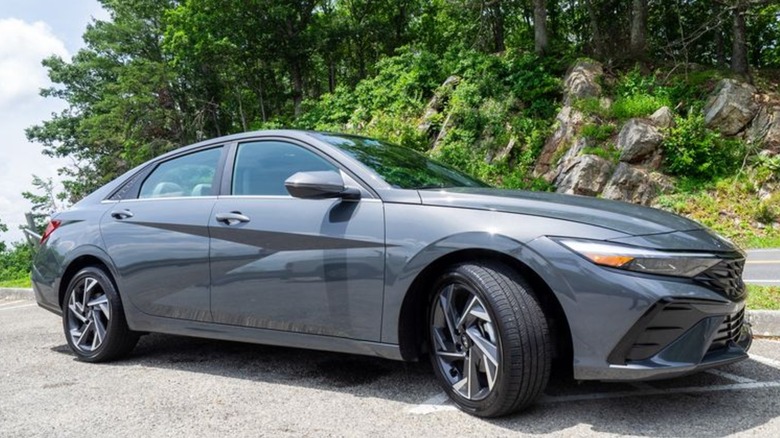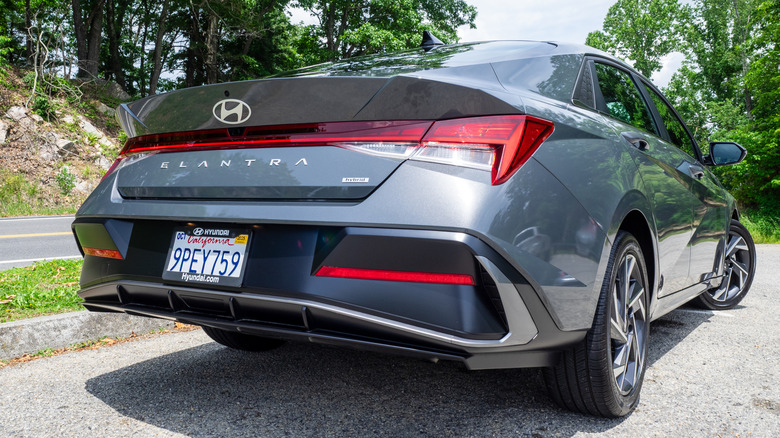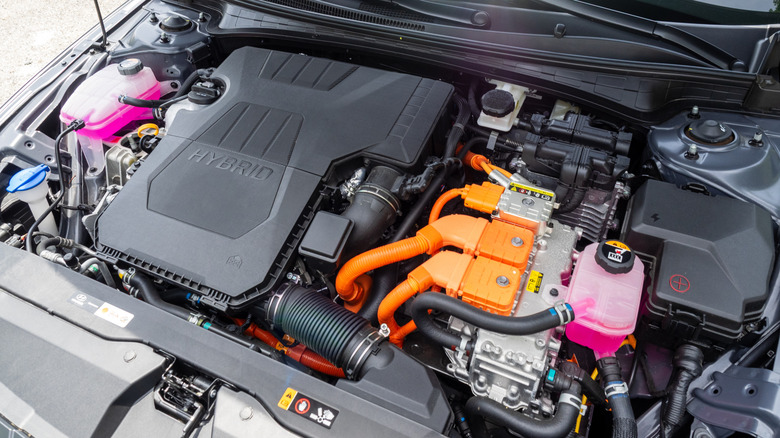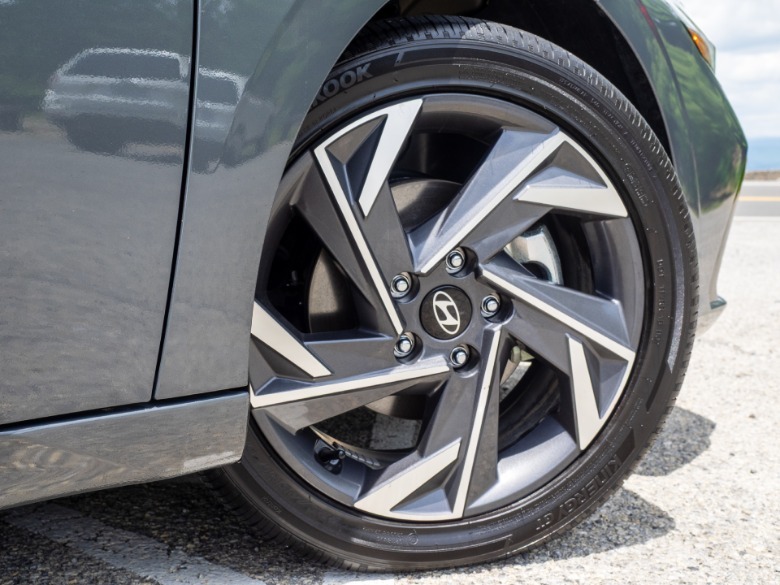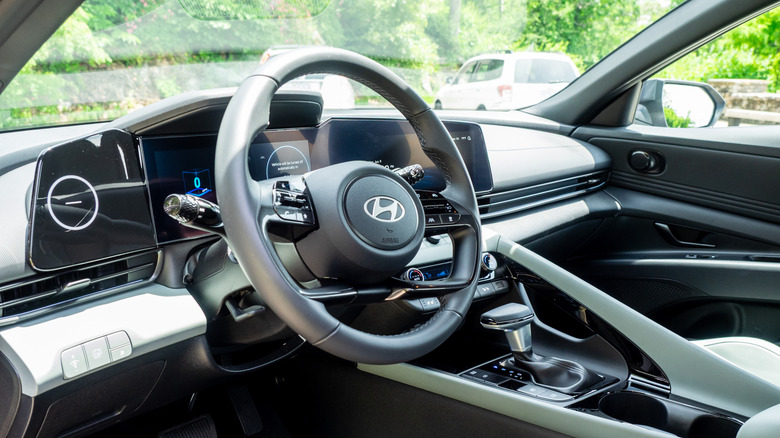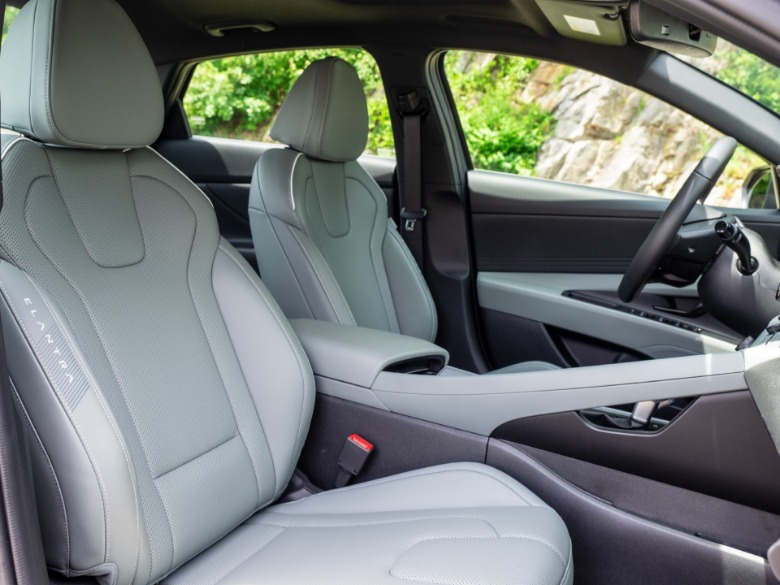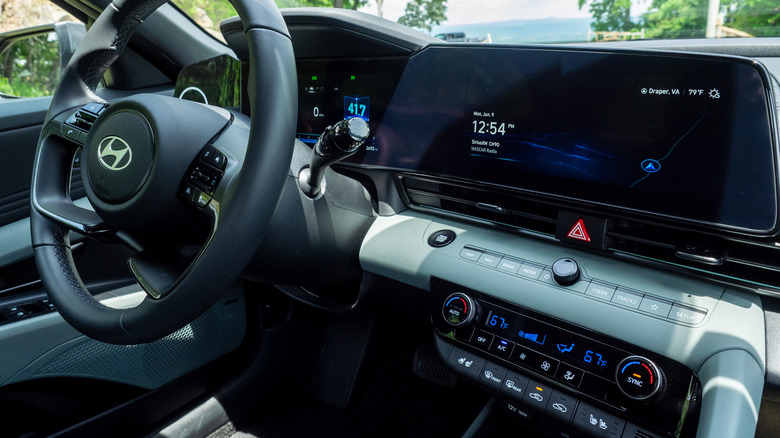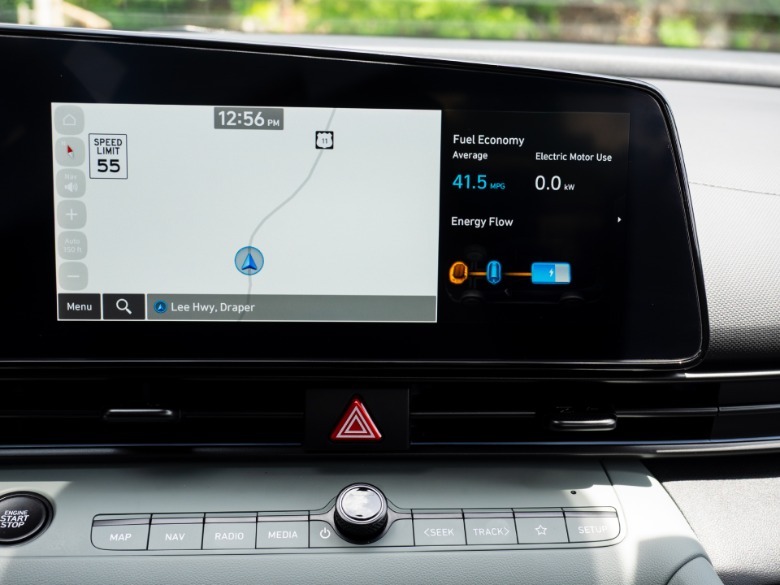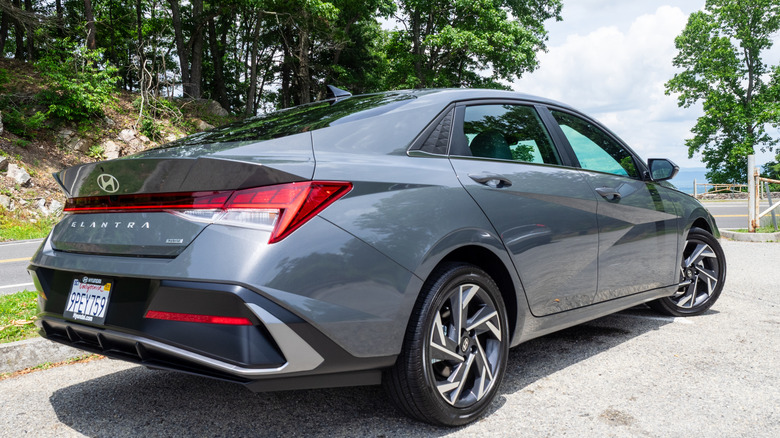2025 Hyundai Elantra Hybrid Review: High Economy, Low Price
Think of the word "hybrid," and one car and iconic shape comes to mind: the Toyota Prius. For many, that's the start and end of any conversation regarding whether one wants a hybrid in their driveway or not. However, the spaceship from Toyota City, Japan isn't the only electrified car on the market in the mid-2020s. Though a small competition, there are plenty of players ready to show the world that the Prius is not the be-all, end-all in fuel economy savings.
One such example is the 2025 Hyundai Elantra Hybrid, a compact sedan that hides a few atypical abilities underneath its well-styled yet still conventional sedan appearance. The first-generation hybrid first arrived for the 2021 model year with the gas-only seventh-generation Elantra, a car that shed its previous jellybean looks for angular, sportier lines befitting the future successor to the Veloster N TCR on the track in its ultimate form, the Elantra N TCR.
Instead of battling Audis and Hondas in IMSA's Michelin Pilot Challenge, though, the Elantra in hybrid form throws punches against both volatile fuel prices and high fuel consumption, protecting the wallet in the long run. To show me all it had to offer, Hyundai sent down a 2025 Elantra Hybrid in its top-tier Limited trim to spend a week with me in Virginia's New River Valley.
A reasonably priced hybrid for everyone
Compared to rivals like the Toyota Prius, Honda Accord Hybrid, and even its own Sonata Hybrid sibling, the 2025 Elantra Hybrid is reasonably priced in its segment. The base Blue trim level kicks things off with a starting MSRP of $25,450 plus $1,150 in destination and delivery fees, a few hundred dollars behind the gas-powered Elantra SEL Convenience ($25,825 plus destination). Speaking of the SEL trim level, though, the new-for-2025 SEL Sport version of the 2025 Elantra Hybrid begins with an MSRP of $27,425 plus destination, though you do lose a few MPGs in making the jump up in trim level (more on that later).
Finally, the Elantra Hybrid Limited — the one I received — hits the ground running at $29,800 base MSRP plus destination; the gas-only version of the same trim is a few thousand less at $26,775 starting MSRP plus destination. As-tested, total sticker with destination was $30,810. At that level, there aren't many options to pick, as this trim has pretty much everything.
You can drop $500 on Serenity White or Ultimate Red if no-cost shades like Ecotronic Gray (this example's color) don't do it for you. Otherwise, you can pay $225 for carpeted floor mats, $40 for a first aid kit, or $125 for mudguards. Regardless, you still won't be paying an arm and a leg for great fuel economy.
Making room for excellent fuel economy
The regular 2025 Hyundai Elantra comes with a couple of engine selections under the hood: a 2.0-liter, 147-horsepower four-cylinder for most trims, and a 1.6-liter turbocharged four-cylinder with 201 horsepower for the top-tier N Line. The separate 2025 Elantra N, meanwhile, throws down 276 horses from its turbocharged 2.0-liter four-cylinder.
Things are a bit different when it comes to the Elantra Hybrid. No matter which trim you choose, you get the same powertrain: a 1.6-liter four-cylinder paired with a single electric motor and a 240-volt lithium-ion battery pack. The gas engine puts out 104 horsepower and 109 lb-ft of torque, while the electric motor brings 43 horses and 125 lb-ft of torque to the table. Combined output comes to 139 hybrid horsies and 195 lb-ft of torque, all going to the front pair of 16- (Blue) or 17-inch (SEL Sport and Limited) alloys; my 17s were wrapped in Hankook Kinergy GTs. Alas, no all-wheel drive for snowier spots.
Unlike a few hybrids that use continuously variable transmissions (CVTs), Hyundai's packs a six-speed dual-clutch automatic. A smidgen of Elantra N, if you will, and definitely one that won't leave your ears aching on the open road compared to the groaning and humming of CVTs. A full set of disc brakes (11 inches up front, 10.3 inches out back) stop the show, while MacPherson struts with coil springs ahead of the driver and a multi-link independent rear suspension help the hybrid comfortably glide through the twists and turns; those who want more athleticism should pick the Elantra N.
The tradition continues on... for now
While more and more of Hyundai's lineup adopts the IONIQ family's dashboard configuration and steering wheel combination, like in the all-electric Ioniq 5 N, the 2025 Hyundai Elantra Hybrid retains its original setup. The shifter's on the center console, and it's not a twistable square nubbin, either. That alone might be a welcome relief for those who prefer something more tangible when it comes to setting things into motion.
The cabin is driver-focused, with everything walled off by the center console's front passenger grab handle rising up to the dashboard itself (a la the C8 era Corvette). For some riding shotgun, though, that might be a bit too cozy (a la the C8 era Corvette).
Cloth seats are the norm for the Blue and SEL Sport tirms, while the Limited wears synthetic leather; the Elantra wordmark on the outer bolster of the front seats is a nice touch. The Limited also offers heated and ventilated seating up front, an eight-way power-adjustable driver's seat with memory (the passenger must do everything manually, alas), a sunroof, and a 60/40-split rear seat. Cargo space in the trunk comes to 14.2 cu-ft.
Front occupants have plenty of legroom at 42.3 inches, though the three adults in the rear might feel a bit cramped with only 38 inches to do the same. Taller passengers would likely prefer the front over the rear when it comes to headroom, but compared to, say, the current-generation Toyota Prius, it's not all that bad. Trim materials aren't too fancy, but they're serviceable.
Blue is for wireless infotainment
Back towards the driver-focused, non-IONIQ-fied dashboard and steering setup, a pair of 10.25-inch screens in a single, flowing housing present everything to the driver quite well. There's also a second panel next to the driver's door that houses a circle, though it doesn't seem to do anything other than exist (not from what I could tell, anyway). The Blue trim offers wireless Apple CarPlay and Android Auto, while the SEL Sport and Limited (like my tester) require wired use, a hangover of Hyundai's odd case of the base trim offering the wireless version while upper trims stay wired.
On the flip side, though, the Blue trim houses its wireless connection within a mere 8-inch touchscreen instead of the larger 10.25-inch unit in the two upper trims; the upper trims do offer wireless device charging, for what it's worth. SiriusXM is available on the SEL Sport and Limited trims, as well as Hyundai's Bluelink+ subscription-based services, and a three-year complimentary Bluelink+ over-the-air (OTA) navigation and map updates service.
I always appreciate physical controls, and the Elantra Hybrid doesn't disappoint here with buttons and knobs for both the dual-zone climate control and the radio. While the two lower trims offer a six-speaker stereo system, the Limited's eight-speaker Bose system made my favorite voices sound their best. The hybrid compact sedan offers a long list of standard safety features, including forward-collision warning, blind-spot monitoring, automatic high beams, and driver-attention monitoring. The Limited adds adaptive cruise control, highway-driving assist, cyclist detection, and intersection assist.
Lonely times for the gas stations ahead
Not only is the Elantra Hybrid relatively easy on the wallet at the dealership, it's quite gentle with it at the pump, too. The hybrid powertrain has an EPA-estimated combined 54 mpg (51 city/58 highway) in the Blue trim, or 50 mpg (49 city/52 highway) in the SEL Sport and Limited trims. The differences in miles per gallon for each trim are likely due to weight and optimization. Still, I only dropped around three gallons of regular 87 octane into the 11-gallon tank after a week of mostly in-town driving, peaking at an outstanding 65.5 mpg, and averaging 43.4 mpg before it went back home.
Unless you really like gas station food (especially if the gas station has its own kitchen like Wawa, Sheetz, Speedway, QuikTrip, Casey's, Buc-ee's etc.), your favorite gas station may long for your missed presence more often than not.
As far as the remainder of the driving experience goes for the Hyundai, it wasn't too bad. It's not a barn-burner like the Elantra N, but it's not supposed to be, either. Instead, comfortable cruising is the order of the day, with its six-speed dual-clutch auto and three driving modes (Sport, Eco, and Smart) managing the power. Passing is not a problem, especially when I had to get by a big rig that wouldn't move over into the left lane for me while I was merging onto the highway from the right. Handling is great, too, though again, it's built for comfort, not track days.
2025 Hyundai Elantra Hybrid Verdict
If nothing else, the 2025 Hyundai Elantra Hybrid proves you don't need to drop thousands upon thousands of dollars to have a fuel-saving commuting cruiser. Its sharp (in about every sense of the word) exterior styling won't be compared to the standard-bearer in the Toyota Prius, allowing the compact sedan to leave that hybrid's baggage behind. And, while it doesn't have the stable of horses the gas-only Elantras possess, it's definitely a vehicle I'd feel safe taking down I-81 to my local airport on the way to an assignment.
The big selling point, though, is the price of admission. Even when you go for the top-tier Limited trim and add a few options to the sheet, you're still going to be under the entry fee for more than a few of this hybrid's competitors. Throw in its excellent fuel economy, long list of standard safety features, and Hyundai's legendary warranties (including the 10-year/100,000-mile powertrain coverage), and you have a total package that just might leave you with a smug grin on your face at both the dealership, the gas pump, and the parking lot next to the competition.
